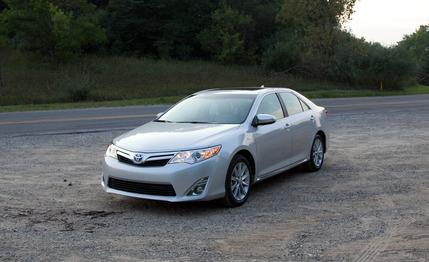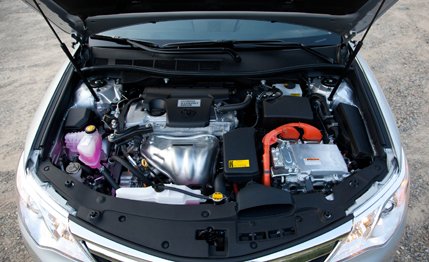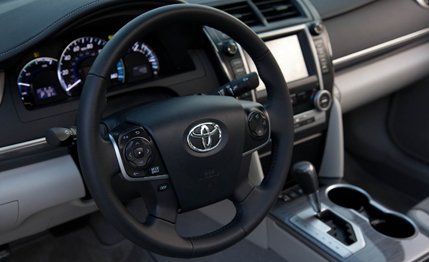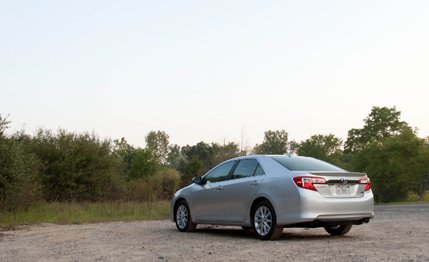
 Instrumented Test
Instrumented Test
“Don’t Rock the Boat” might not translate directly into Japanese, but Toyota engineers clearly followed words to such effect while crafting the new, second-generation Camry hybrid. Like the conventional gas-powered models, the gas-electric Camry is different and better than its forebear, although you’ll need a magnifying glass to identify many of the changes.


The most significant dimensional deviation is a 0.4-inch increase in overall height, attributable to a slightly more-wedge-like profile. The cargo hold was stretched to 13.1 cubic feet, representing a gain of 2.5 cubes achieved by reconfiguring and relocating the 150-pound battery pack. (Because of the pack’s location, only the right-side rear seatback folds to accommodate long objects.) Passenger space is up slightly, from 101.4 cubic feet to 102.7, keeping the Camry hybrid smack in the middle of the EPA’s midsize-sedan category.
Lighter and More Efficient
What the magnifying glass won’t reveal is that the more extensive use of high-strength steel has trimmed what Toyota says is about 220 pounds of weight while increasing rigidity in comparison with the last Camry hybrid we tested. Add to that a slick 0.27 coefficient of drag and improved low-rolling-resistance tires, and you get quicker acceleration and better mileage. More on that later.


Toyota’s Hybrid Synergy Drive system still relies on one transversely mounted four-cylinder engine, two electric motor/generators, and a planetary-gear CVT to power the front wheels. A slight increase in engine displacement—from 2.4 to 2.5 liters—and a thorough retuning raised power and torque (to 156 hp at 5700 rpm and 156 lb-ft at 4500 rpm). Switching to electric drive for the air-conditioning compressor and engine-coolant pump eliminated all accessory drive belts. The main motor/generator, which produces more peak torque (199 lb-ft) and nearly as much peak power (141 hp) as the engine, drives the wheels and generates electricity to recharge the battery pack during deceleration. The smaller motor/generator restarts the gas engine after shutdown at stoplights, generates electricity for recharging the battery and powering the main motor/generator, and regulates the drive ratio between the engine and front wheels.
No one will have difficulty recognizing the new Camry as a member of America’s favorite—at least in terms of sales—car family. Viewed next to the conventionally powered models, grille and lamp changes are as close as this latest edition comes to rocking the smooth-sailing boat. To signal the owner’s environmental consciousness, there are three hybrid badges—one per front fender, another on the trunk.
Inside, the trim has been upgraded to address well-deserved gripes. The addition of brushed aluminum accents, an elegantly stitched dash topper, and more-contemporary grain patterns should help stem the tide of customers fleeing toward Hyundai. The set of three bright “optitron” dials in the hybrid’s multi-information display conveys more mileage, range, and energy-flow information than the most curious driver could desire. Additional energy-related menus are provided in the central touchscreen included with the uplevel audio and navigation systems. Dual-zone automatic climate control is standard; a tasteful combination of leather and Ultrasuede seat trim is an $1160 option in uplevel XLE editions like our test vehicle. As in other Camrys, there are no fewer than five audio-and-navigation combinations, but you first must opt out of the base LE hybrid ($26,660) to take that walk. Step one is the base setup. The first upgrade (standard in the $28,160 XLE) brings the 6.1-inch center touchscreen. The next step adds navigation and Toyota’s Entune multimedia system. Next comes the more entertaining JBL audio, and the final step brings a deluxe HDD navigation system splashed across a seven-inch touchscreen.


The lighter weight, the low drag, and the powertrain overhaul pay off with major mpg gains. Compared with the outgoing model, EPA city mileage for 2012 LE hybrids soars a remarkable 12 mpg to 43 mpg, and highway mileage is 4 mpg better at 39. XLE models like ours are rated for 40/38, and we got 30 mpg overall; a more careful driver’s mileage will surely vary upward. To help owners achieve phenomenal efficiency, there are two new driving modes. The eco setting significantly inhibits throttle openings and reduces the air-conditioning system’s power consumption. The EV mode allows driving solely on electric power for up to 1.6 miles at speeds below 25 mph.
The notion that Toyotas top the boredom charts in the driving-dynamics category has finally registered back at home base. For the seventh-generation Camry, engineers were challenged to maintain a baby-stroller ride while improving handling, agility, braking performance, and driver feedback. The gains they’ve achieved are significant but not enough to raise eyebrows among the leading sports-sedan makers.
Fleeter of Foot, Too
At least the combination of less weight and more available power trims 0-to-60-mph acceleration by 0.4 second to a more palatable 7.3 seconds, beating a standard four-cylinder Camry SE by half a second to 60 and through the quarter-mile by 0.6 second and 4 mph. The Kia Optima and Hyundai Sonata hybrids fall way behind, turning in 60-mph acceleration runs in the mid-nine-second range and a quarter-mile elapsed time slower by more than a second. Ford’s Fusion hybrid slides into second place ahead of the Koreans but behind the new Camry in straight-line vitality.
We measured a significantly shorter 70-to-0-mph stopping distance—178 feet—versus the previous Camry hybrid’s 200 feet. The blend of friction and electrical braking is smooth enough that you seldom detect queasiness or nonlinearity in the pedal.


The electrically assisted power steering—it originated in the previous hybrid and has spread across all Camrys—provides smidgens of feedback, a refreshing change for any Toyota. It’s tuned to adjust effort according to car speed and how rapidly the steering wheel is turned.
The annoying acceleration drone that comes standard with continuously variable transmissions has been reduced with revised engine controls and a heavy blanket of underhood sound deadening. The front seats have longer bottom cushions and taller backrests but not enough lateral stiffness to keep front occupants in place during hard cornering. A minor reshaping of the front seatbacks and center console has improved rear-seat knee- and legroom, especially for the center passenger.
Threatened by others elbowing into the hybrid-sedan game, Toyota has responded with a new Camry hybrid that is a stalking horse of sorts. It’s significantly more fuel efficient, notably quicker, and even a tad more satisfying to drive than before. The mid-20s through mid-30s pricing is on the high side, but with value factored into the equation, the 2012 model should hold its own against the rising tide. And for anyone who’s hooked on 40-plus mpg but tired of wacky (read “Prius”) design, the Camry hybrid will seem like the answer to a question he or she never dreamed of asking.